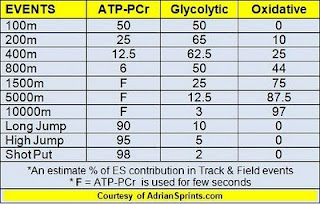The body uses three energy systems to produce energy in the form of ATP (Adenosine triphosphate). The body decides what energy system will best serve its needs depending on for example; the exercise intensity or the duration. We’ll try and keep this as simple as possible so that everyone can understand this.
Energy systems:
- ATP-Pcr System (Phosphagen System)
- Glycolysis (Lactic Acid System)
- Oxidative System
ATP-PCr:
This energy system is used for the first 10sec of any activity regardless of intensity. It is primarily used in sports requiring short, explosive bouts of activity lasting less than 10sec e.g. 100m, 110m hurdles and all field events.
This energy system makes use of stored up ATP to provide the body with energy as well as stored phosphocreatin to replenish the ATP stores. There is a limited amount of phosphocreatine in the body and thus does not last very long.
ATP = ADP + P + Energy
ATP is broken down into ADP, a phosphate molecule and energy that powers the body. Because the breakdown of ATP releases more energy than the breakdown of ADP the body always tries to replenish the ATP stores. Phosphocreatine (PCr) accomplishes this by donating its phosphate molecule to ADP to form ATP.
ADP + PCr < Creatine kinase > ATP + creatine = ATP
Glycolysis (Lactic Acid System)
Glycolysis is the breakdown of carbohydrates in order to restore the body’s ATP. This is an anaerobic reaction and does not require oxygen. This energy system takes over when the body is active for more than 10sec up to about 3min e.g. 400m, 800m
Glucose either stored in the muscles as glycogen or from the blood is used to synthesize ATP. This process involves several complicated reactions. The end result in the presence of oxygen is pyruvate which is used in the oxidative system as fuel source. Pyruvate in the absence of oxygen is converted to lactate and an H+ (hydrogen ion). Lactate is often been said to be a waste product or the cause of fatigue or cramp. This is not entirely true as lactate, when transported to the liver, can be used to synthesize glucose thus acting as a fuel source to the body. Fatigue and muscle cramps are theorised to originate from the build up of H+ associated with the formation of lactate in the absence of oxygen from pyruvate. The H+ causes the muscle to become acidic and this decreases the muscle’s ability to function properly.
Oxidative System
The oxidative system makes use of four processes to produce ATP:
- Slow glycolysis (aerobic glycolysis)
- Krebs cycle (citric acid cycle or tricarboxylic acid cycle)
- Electron transport chain
- Beta oxidation
We’ll just cover the basics here:
The oxidative system is a slow energy yielding system that uses oxygen to produce energy. It becomes active after about 3min when an activity is slow and continuous and the body reaches a steady state of activity e.g. 1200m and greater distances
Pyruvate is converted to Acetyl-CoA and enters the Krebs cycle where many enzymes act on this substance causing several reactions yielding ATP. Glucose can also be used to sustain the Kreb’s cycle directly. The metabolism of fat, carbohydrates or protein follows the same path into the Kerbs cycle; these substrates can enter either as pyruvate or glucose, the main difference here is that pyruvate is converted to Acetyl-CoA and glucose enters directly into the Krebs cycle without having to be converted first.
Many processes and reactions take place here and the detail is super complicated, but the bottom line is ATP, H2O, CO2 and H+ are the end products of the oxidative system.
Here is a table showing the predominant energy systems being used in different events:
 |
| Figure 1.1: energy demands in athletics |
To achieve the best performance in your specific event, you need to train specific to your event’s energy demands. The body adapts to the needs of your sports in order to increase your efficiency there in e.g. a sprinter’s body stores more ATP and PCr which means his body can produce ATP during the ATP-PCr system more rapidly and for a few seconds longer. This gives him the ability to compete at a higher intensity for a bit longer.
If anyone out there has a question on the energy systems or on athletics, please feel free to send me your questions and I will make sure to get back to you as soon as possible.
References:
Jack H. Wilmore, David L. Costill. (2004). Physiology of Sport and Exercise (Third ed.). Champaign, IL: Human Kinetics.
William D. McArdle, Frank I. Katch, Victor L. Katch. (2010). Exercise Physiology (Nutrition, Energy and Human Performances (Seventh ed.). Philadelphia, PA: Lippincott William & Wilkins.
Energy demands of athletics table 1.1. coutesy of AdrianSports.com
Armant Goldswain
Bachelor of Sports Science






